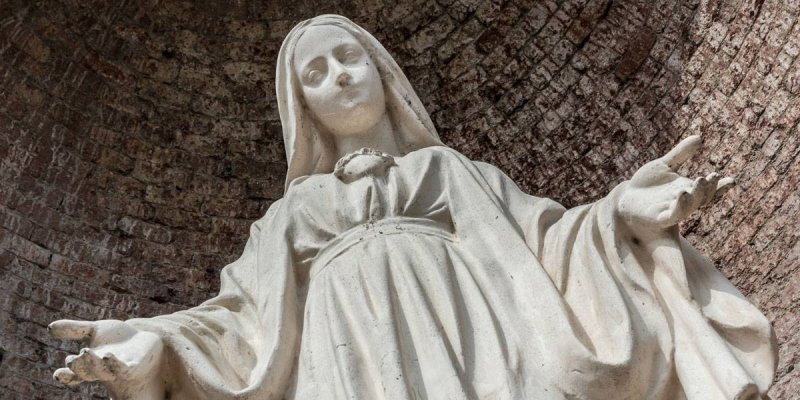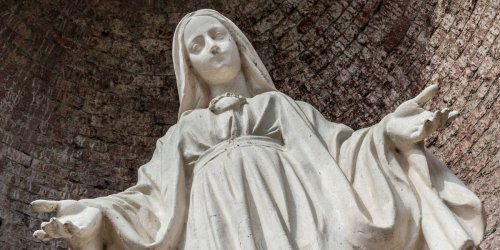For many centuries, in the early days of Christianity, Saint Mary had not yet been consecrated as the first woman when it came to the symbols of Christianity. Another woman, another virgin maiden, took center stage and is still heavily present in the veneration and religious fervor of Christians, particularly in the Near East.
Who is this other virgin, and why did her veneration prevail for centuries before it climbed down from the lead in favor of the "Centrality of Virgin Mary"? Immediately after the Blessed Virgin Mary, Saint Thecla still holds the number one "popular" ranking among Christian groups in the Near East, whether in terms of venerating and honoring her, following her example, or in the form of her presence in the collective imagination. Her top rank is earned for being the first woman martyr in the Church, having been martyred several times, saved multiple times, and appearing after death several times. This is something that transformed a large swath of the geography of Asia Minor (Anatolia), the Levant, and Egypt into a network of pilgrimage sites and holy shrines associated with this saint, most important of which is the cave known as "Aya Takla" (or “Aya Thecla”) in the Mersin region in Turkey - where it is widely believed that Thecla became pious and devout or was buried there - as well as the Convent of Saint Thecla (‘Deir Mar Takla’) in “Salafkia al-Sham”, or ‘Maaloula’, also near a cave where Thecla is believed to have hidden. The pilgrimage to Thecla - to her various holy sites and shrines - was the first ever pilgrimage in Christianity. Today, Saint Thecla does not enjoy this degree of popularity outside the Near East region anymore, even though churches named after her remain second only to those named after Mary, mother of God, across the world.
Saint Thecla’s top rank is earned for being the first woman martyr in the Church; Having been martyred several times, saved multiple times, and reappearing after death several times.
An Equal to Apostles or an Apostle Herself?
During the first centuries of Christianity, Thecla was not yet second in rank after Mary, mother of Christ, but for a relatively long time, she kept the first rank, in terms of reverence, veneration and the spread of her miraculous experiences within popular literature; for she was a paradigm for the "Absolute Virgin" and a martyr who had been martyred several times in a row. The shift from "the veneration of Thecla" to "the veneration of Mary" - as a center for the presence of women in the system of Christian sacred symbols - would change many of the characteristics of the Christian religion itself. To this day, Eastern Churches still view the martyr Saint Thecla as "equal to the apostles", even though this recognition has become vague and more ambiguous with time. Then, it was a portrayal of a popular religion practiced enthusiastically over centuries, so much so that Thecla was viewed as the culmination of "the Apostolic tradition" in Christianity, which begins with the disciples of Christ, and is completed with Paul the Apostle. Thecla, who Eastern Churches view today as an "equal to the Apostles", was a candidate in the first centuries of Christianity to be consecrated as an "apostle" herself. Only after the theology of early Church Fathers was developed in such a way that it dominated the enthusiasm of popular worship for Thecla - excluding women from all "priesthood" positions and constricting them with the right to "monasticism” (or monkhood) only - did the paradigm shift take place to give the central role to Mary and not to Thecla.
To this day, Eastern Churches still view the martyr Saint Thecla as equal to the Apostles, even though this recognition has become vague and more ambiguous with time.
The Absolute Virgin that Never Married nor Gave Birth
If we go back in time to the second and third centuries after Christ, and talk to the Christians of Asia Minor or Syria about “the Virgin", they would take our words in the conversation to mean Thecla, the daughter of an iconic city (present-day Konya in Turkey). Following Paul's delegation to her city and after secretly listening to him from the window of her room, She decided to abandon her fiancé the prince, completely change her mind about the idea of marriage, and take a ‘vow of virginity’. However, in the popular religious literature that prevailed for centuries, this vow of virginity was not only tied to Jesus ‘the heavenly groom’, but rather a narrative framework was created for the pure virgin love between Thecla and Paul, if we refer to the text of "The Acts of Paul and Thecla", which roamed the East for a long time in various languages, and which the Church considers a fake. However, its diverted nature was not sufficient enough to prevent its spread, and the text still exerts influence on the perceived image of Thecla, in some form or another. This type of popular religious literature was clearly intended to entertain listeners, as Bart Ehrman reminds us in his book “Forgery and Counterforgery: The Use of Literary Deceit in Early Christian Polemics”. Since there were common narratives among pagans featuring heroes in many travels and adventures before and after their death - through the practice of magic and suspense with their daring escapes from impending disaster, painful separations from lovers, and joyful reunions afterwards - this popular literary tradition found it way among early Christians as well.
Exotic Folk Literature And Wild Seals
In this text, Thecla ends her engagement, despite the anger of her fiancé and outcries of her mother, leading to Paul's imprisonment. She then sneaks into his cell despite the guards, and stays the night with him, kneeling at his feet, kissing his handcuffs. It was quite another shock to her fiancé when he saw her like this in the morning, so Paul was flogged and expelled from the city, while Thecla’s mother went out calling for her execution. A fire is lit around her but does not touch her, then divine protection extinguishes the fire with thunder and rain. After that, Thecla is released, and she set out in search for Paul - as is the case in most of the entire tale. When she finds him, she requests to accompany him in travel, and cut her hair in order to facilitate his acceptance of her companionship in his evangelistic (missionary) journeys, but Paul refuses to give her the sacrament of baptism, because he was not yet sure of her faith. When Paul and Thecla reach Antakya, a new ordeal faces them. A young notable man named Iskandar is quite taken by her and follows her between the alleys. He then talks to Paul about the issue, with the latter denying knowing the girl. Iskandar tries to approach her in vain, and when she rejects him, he attempts to rape her. But she proves able to hit him, tear his clothes, and humiliate him in public. While Paul - who had denied her - disappears from this exotic, she is taken to prison again and left prey to predators, where divine protection once again intervenes to save her. A lioness bows to her instead of devouring her, then it attacks a bear that tries to prey on her. Many animals are set on her so she escapes to a pond full of man-eating seals. Once again, Thecla escapes and is surrounded by clouds from the sky that conceal her nudity. She even baptizes herself in the waters of the wild seals pond; hence the tale of "The Acts of Thecla" later becomes a basis for the path that allowed women to supervise baptisms and pontifical functions in general - in contrast to the prevailing current that had restricted pontifical functions to men only - based on Paul's letters in the New Testament.
Family Or Celibacy?
This exotic text exerted its influence on popular literature and religion for a long time, with Bart Ehrman reminding us that this type imitates popular pagan narratives, but in practice, completely turns it upside down. Unlike popular pagan narratives, this type of religious literature in "The Acts of Thecla" calls for absolute love, purity, and virginity, instead of erotic love, which is viewed as a sin that must be avoided. The narrator urges the listeners to escape from this worldly life and its social and logical limitations. In parallel, this popular fiction was not easy to frame in topics that will later become of great importance in the history of Christianity, especially the concept of family. So Thecla - not only in this work of literature, but even in today’s church-approved narrative of her - is not a symbol of family. Rather she symbolizes the severing of the ties of kinship, the dissolution of engagement, and the abstention from marriage and childbearing, unlike Mary who would become the center of the "Holy Family" (Jesus, Mary, and Joseph), that Christians will have to replicate.
"Theclawis" Inside And Outside Family
In his book “The Cult of Saint Thecla: A Tradition of Women's Piety in Late Antiquity”, Stephen J. Davis shows how Christianity worked to contain this “absolute virgin” (Thecla) within a familial framework that would then be consecrated. Athanasius the First, Bishop and Saint of Alexandria in the 4th century AD, refers to Thecla in his letter "A Discourse On Virginity", and the centrality of her narrative to be simulated by "Theclawis" - that is, female believers who vow their lives to follow the path of this martyr saint and be like her. But another text pertaining to Athanasius left a strong impact for a long time, requiring every Christian family to vow one of its daughters within the house to permanent virginity, and that this will bring forth blessings to all family members. It also asks that if there is no such "domestic Theclawi" girl, then she must be replaced with a maid to take up this role.
Thecla proposes the concept of a "Christian feminist" in this ancient era, especially since she baptized herself and faced the authority of her mother, her fiancé and a group of tyrannical rulers
Thecla proposes the concept of a "Christian feminist" in this ancient era, especially since she baptized herself and faced the authority of her mother, her fiancé and a group of tyrannical rulers; with the "Acts of Thecla" addressing her boldness in Antakya and Paul's abandonment of her, to later return and narrate their reunion as well. This text also singles out a prominent position for the daughters of Antakya who rose up in defense of Thecla, and for the lioness that saved her from lions and bears. Thecla was one of the early believers in Christianity, a new religious movement that gave women a justification for travel at the time before anything else. She roamed towns and villages, in the name of preaching and evangelization, to frame the "geography" of the Near East while following her footsteps and the myths woven around her. The main bulk of this fictional heritage was lost with the turn of the century, but also many manuscripts were adequately preserved, to attest to the period that began Christianly with the popularity of the “veneration of Thecla”, and then ended with the forefront of the “veneration of Mary”, with Thecla remaining engraved in the popular conscience of Christians of the East, albeit without the unbridled "feminist" tradition that "The Acts of Thecla" reflects.
Raseef22 is a not for profit entity. Our focus is on quality journalism. Every contribution to the NasRaseef membership goes directly towards journalism production. We stand independent, not accepting corporate sponsorships, sponsored content or political funding.
Support our mission to keep Raseef22 available to all readers by clicking here!
Interested in writing with us? Check our pitch process here!






